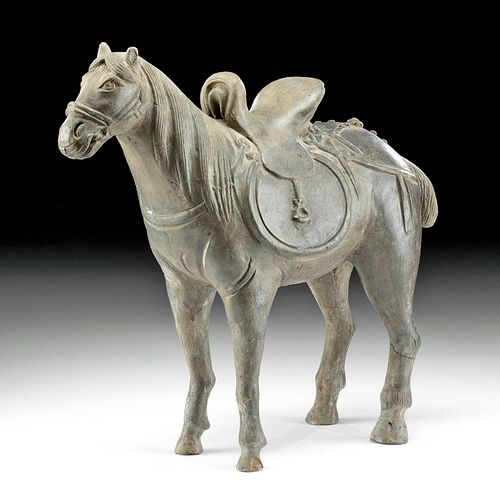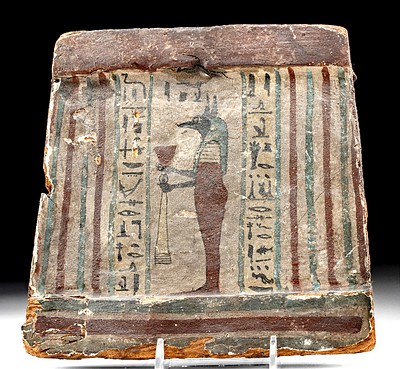Chinese Yuan Dynasty Pottery Standing Horse w/ TL
Lot 64b
About Seller
Artemis Fine Arts
686 S Taylor Ave, Ste 106
Louisville, CO 80027
United States
Selling antiquities, ancient and ethnographic art online since 1993, Artemis Gallery specializes in Classical Antiquities (Egyptian, Greek, Roman, Near Eastern), Asian, Pre-Columbian, African / Tribal / Oceanographic art. Our extensive inventory includes pottery, stone, metal, wood, glass and textil...Read more
Categories
Estimate:
$3,000 - $4,500
Absentee vs Live bid
Two ways to bid:
- Leave a max absentee bid and the platform will bid on your behalf up to your maximum bid during the live auction.
- Bid live during the auction and your bids will be submitted real-time to the auctioneer.
Bid Increments
| Price | Bid Increment |
|---|---|
| $0 | $25 |
| $300 | $50 |
| $1,000 | $100 |
| $2,000 | $250 |
| $5,000 | $500 |
| $10,000 | $1,000 |
| $20,000 | $2,500 |
| $50,000 | $5,000 |
| $100,000 | $10,000 |
| $200,000 | $20,000 |
About Auction
By Artemis Fine Arts
Aug 26, 2021
Set Reminder
2021-08-26 10:00:00
2021-08-26 10:00:00
America/New_York
Bidsquare
Bidsquare : Fine Antiquities | Asian | Ethnographic Art
https://www.bidsquare.com/auctions/artemis-gallery/fine-antiquities-asian-ethnographic-art-7366
Features classical antiquities, ancient and ethnographic art from cultures encompassing the globe. Egyptian, Greek, Roman, Etruscan, Near Eastern, Asian, Pre-Columbian, Native American, African / Tribal, Oceanic, Spanish Colonial, Russian, Fine / Visual Arts, so much more! Artemis Fine Arts info@artemisfinearts.com
Features classical antiquities, ancient and ethnographic art from cultures encompassing the globe. Egyptian, Greek, Roman, Etruscan, Near Eastern, Asian, Pre-Columbian, Native American, African / Tribal, Oceanic, Spanish Colonial, Russian, Fine / Visual Arts, so much more! Artemis Fine Arts info@artemisfinearts.com
- Lot Description
East Asia, China, Yuan Dynasty, ca. 1271 to 1368 CE. A remarkable mold-made pottery horse shown standing and rendered with impressive detail. Formed from a uniquely hued, dark gray clay, this noble steed is depicted naturalistically, presenting a round snout with incised nostrils, bulging, almond-shaped eyes, and perky ears, all surmounted by a centrally parted mane that flows down both sides of his long neck. A short tail extends outwards from his posterior, while an elaborate saddle sits atop his back, displaying large saddle flaps and a high-rising pommel and cantle. His snout and back end are also adorned by intricate harnesses, with a crisscross of straps on his buttocks displaying several applied clay buttons. Size: 10.8" L x 4.2" W x 10" H (27.4 cm x 10.7 cm x 25.4 cm)
According to Zhixin Jason Sun, Curator of the Department of Asian Art at the Metropolitan Museum of Art, "The importance of horses rose to new heights in the Tang dynasty (618 to 907) when, as emblems of imperial power, they marched in state processions, galloped through royal hunting parks, raced across polo fields, and even danced before the emperor. Their portraits were painted by leading court artists, and their majestic form was modeled in brightly glazed pottery as tomb figurines and sculpted on marble plaques to adorn emperors' tombs as symbols of dynastic vitality." Beyond this, the horse played a significant role in the unification of the Chinese Empire, as the ancients could communicate to parties near and far due to the great speed of these noble steeds. The horse also assisted the military to conquer distant lands and grow the empire. As the desire for stronger, faster breeds grew, the ancients imported horses from Central Asia, leading to the creation of the famous Silk Road.
We see evidence of the reverence for the horse in the visual culture of ancient China. Imagery of horses abound in painting, literature, and sculpture. During the Tang dynasty, artists created burial art representing these revered animals. This particular piece depicts a large charger; this type of horse served as both a symbol of imperial stability that engendered bountiful trade and prosperity for the expanding empire and the reward of military exploits to the west. The most cherished horses were raised in the western kingdom of Ferghana and known as "blood-sweating horses." These were delivered as tribute to the reigning emperor. In general, for the ancient Chinese, horses were a sign of wealth.
This piece has been tested using thermoluminescence (TL) analysis and has been found to be ancient and of the period stated. A full report will accompany purchase.
Provenance: private Hawaii, USA collection; ex-private Hawaii, USA collection; ex-Splendors of the World, Hawaii, USA, before 2010
All items legal to buy/sell under U.S. Statute covering cultural patrimony Code 2600, CHAPTER 14, and are guaranteed to be as described or your money back.
A Certificate of Authenticity will accompany all winning bids.
PLEASE NOTE: Due to recent increases of shipments being seized by Australian & German customs (even for items with pre-UNESCO provenance), we will no longer ship most antiquities and ancient Chinese art to Australia & Germany. For categories of items that are acceptable to ship to Australia or Germany, please contact us directly or work with your local customs brokerage firm.
Display stands not described as included/custom in the item description are for photography purposes only and will not be included with the item upon shipping.
#164590TL holes under snout and inside of proper left hind leg. Bottom parts of legs have been repaired and restored. Repair to saddle and tail with restoration over break lines. Chips to tips of ears, as well as some minor chips, nicks, and light abrasions in some areas. Otherwise, excellent with remarkable preservation of detail.Condition
- Shipping Info
-
All shipping is handled in-house for your convenience. Your invoice from Artemis Gallery will include shipping calculation instructions. If in doubt, please inquire BEFORE bidding for estimated shipping costs for individual items.
-
- Buyer's Premium



 EUR
EUR CAD
CAD AUD
AUD GBP
GBP MXN
MXN HKD
HKD CNY
CNY MYR
MYR SEK
SEK SGD
SGD CHF
CHF THB
THB














